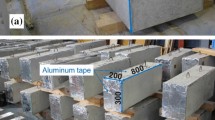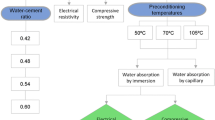Abstract
Adequate moisture is very important during early age of portland cement concrete. The Single Point Magnetic Resonance Imaging technique was used to study the effects of various lengths of moist curing, and the use of curing compound, on the amount and distribution of evaporable water during drying of ordinary and high performance concrete. The specimens subjected to six different curing regimes, were cast in triplicate for a total of 72. After moist curing at 38°C, the specimens were subjected to uniaxial drying in an environmental chamber at 38°C and 40% relative humidity that simulated hot dry climate conditions. As the specimens were drying, Magnetic Resonance Imaging was used to study the evaporable water distribution, non-destructively and with millimetric resolution. The Magnetic Resonance Imaging profiles indicated a reduced moisture loss with increasing length of moist curing. Extended moist curing was especially beneficial for the two self-compacting concrete mixtures, particularly for the cover concrete. In all mixtures the use of curing compound was only marginally better than one day moist curing, but was significantly better than air curing, particularly for the cover concrete. The moisture diffusivity was evaluated from the transient moisture distribution profiles using the Boltzmann transformation method. The results indicated a strong dependence of the moisture diffusivity on the moisture content when above 80% saturation, whereas below this value it remains almost constant. The moisture diffusivity is significantly reduced with increased moist curing period.
Résumé
Le maintien d'un taux d'humidité adéquat est très important pour un béton frais. La technique d'imagerie à résonance magnétique (à un point) est utilisée pour étudier les effets de la longueur de la période de mûrissement à l'humidité et de l'utilisation de produits de mûrissement sur la quantité et la distribution de l'eau évaporable lors du séchage du béton ordinaire et du béton à haute performance. Les échantillons aussjettis à six différents régimes de mûrissement, sont moulés en trois exemplaires pour un total de 72. Après mûrissement à l'humidité à une température de 38°C, les échantillons sont soumis à un séchage uniaxial dans un environnement contrôlé à une température de 38°C et une humidité relative de 40% pour simuler des conditions climatiques chaudes et sèches. Lors du séchage, une technique non-destructive, par imagerie à résonance magnétique, est utilisée pour étudier la distribution d'eau évaporable avec une résolution au millimètre près. Les profils obtenus par imagerie à résonance magnétique indiquent une réduction de la perte d'humidité lorsque de la période de mûrissement à l'humidité est prolongée. Un mûrissement à l'humidité prolongé est bénéfique spécialement pour les deux mélanges de bétons auto-plaçants, particulièrement pour le béton de surface. Pour les mélanges étudiés, l'utilisation de produits de mûrissements ne montre qu'une faible amélioration par rapport au mûrissement à l'humidité pendant un jour, mais offre un net avantage par rapport au mûrissement à l'air, particulièrement pour le béton de surface. Le coefficient de diffusion de l'humidité est évalué à partir du profil transitoire de la distribution de l'humidité au moyen de la transformation de Boltzmann. Les résultats indiquent que le coefficient de diffusion de l'humidité dépend fortement du degré d'humidité lorsque celui-ci est supérieur à 80% du degré d'humidité à la saturation. En deçà de ce niveau, il est presque constant. Le coefficient de diffusion de l'humidité diminue significativement avec l'allongement de la période de mûrissement.
Similar content being viewed by others
References
Neville, A. and Aitcin, P., ‘High-performance concrete—An overview’,Mater. Struct. 31 (206) (1998) 111–117.
ACI Committee 308-99, 2001, ‘Curing of Concrete’, ACI, Farmington Hills, MI, pp. 305R-1–305R-20.
Ho, D. and Chirwin, G., ‘A performance specification for durable concrete’,Construction and Building Materials 10 (1996) 375–379.
Berhane, Z., ‘The behavior of concrete in hot climates’,Mater. Struct. 25 (1992) 157–162.
Soroka, I. and Ravina, D., ‘Hot weather concreting with admixtures’,Cement and Concrete Composites 20 (1998) 129–136.
Yahuan, C. and Detwiler, R., ‘Backscattered electron imaging of cement pastes cured at elevated temperatures’,Cement and Concrete Research 25 (3) (1995) 627–638.
Powers, T.C., ‘A discussion of cement hydration in relation to the curing of concrete’, Proceedings,Highway Research Board 27 (1947) 178–188.
Aitcin, P.C., ‘Demystifying autogenous shrinkage’,Concrete International, American Concrete Institute 22 (11) (1999) 54–56.
Okamura, H., ‘Self-compacting high performance concrete’,Concrete International, American Concrete Institute 19 (7) (1997) 50–54.
Yurugi, M., Sakata, N., Iwai, M. and Sakai, G., ‘Mix proportions for highly workable concrete’, in ‘Concrete 2000’, ed. R. K. Dhir and M. R. Jones (1993) 579–589.
Khayat, K., ‘Workability, testing, and performance of self-consolidating concrete’,ACI Materials Journal 96 (3) (1999) 346–353.
Persson, B., ‘A comparison between mechanical properties of self-compacting concrete and the corresponding properties of normal concrete’,Cement and Concrete Research 31 (2001) 193–198.
Selih, J. and Bremner, T. W., ‘Drying of saturated lightweight concrete: an experimental investigation’,Mater. Struct. 29 (1996) 401–405.
Akita, H., Fujiwara, T. and Ozaka, Y., ‘A practical procedure for the analysis of moisture transfer within concrete due to drying’,Magazine of Concrete Research 49 (179) (1997) 129–137.
Bentz, D.P. and Hansen, K.K., ‘Preliminary observations of water movement in cement pastes during curing’,Cement and Concrete Research 30 (2000) 1157–1168.
Pleinert, H., Sadouki, H. and Wittmann, F.H., ‘Determination of moisture distributions in porous building materials by neutron transmission analysis’,Mater. Struct. 31 (208) (1998) 218–224.
Beyea, S.D., Balcom, B.J., Bremner, T.W., Prado, P.J., Green, D.P., Armstrong, R.L. and Grattan-Bellew, P.E., ‘Magnetic Resonance Imaging (MRI) of concrete drying profiles’,Cement and Concrete Research 28 (3) (1998) 453–446.
Bohris, A.J., Goerke, U., McDonald, P.J., Mulheron, M., Newling, B. and Le Page, B., ‘A broad line NMR and MRI study of water and water transport in portland cement pastes’,Magnetic Resonance Imaging 16 (5/6) (1998) 455–461.
Balcom, B.J., ‘SPRITE imaging of short relaxation time nuclei’, in ‘Spatially Resolved Magnetic Resonance’ ed. P. Blümler, B. Blumich, R. Botto and E. Fukushima (Wiley-VCH, Weinheim, 1998).
Beyea, S.D., Balcom, B.J., Bremner, T.W., Armstrong, R.L. and Cross, A.P., ‘The influence of micro cracking on the drying behavior of white Portland cement using Single Point Imaging (SPI)’,Solid State NMR 13 (1–2) (1998) 93–100.
Hamad, B.S., ‘Investigations of chemical and physical properties of white cement concrete’,Advanced Cement Based Materials 2 (1995) 161–167.
Powers, T.C., Copeland, L.E. and Mann, H.M., ‘Capillary continuity or discontinuity in cement pastes’,Journal of Portland Cement Association, Research and Development laboratories 1 (2) (1959) 38–48.
Praul, M.F., ‘Curing for HPC bridge decks-bring on the water’,HPC Bridge Views 15 (2001) 1.
Ramezanianpour, A. and Malhotra, V.M., ‘Effect of curing on the compressive strength, resistance to chloride ion penetration and porosity of concretes incorporating slag, fly ash or silica fume’,Cement and Concrete Research 17 (1995) 125–133.
Holt, E., ‘Where did these cracks come from?’,Concrete International, American Concrete Institute 23 (9) (2000) 57–60.
Kovler, K., ‘Shock of evaporative cooling of concrete in hot dry climates’,Concrete International, American Concrete Institute 17 (10) (1995) 65–69.
Bentz, D.P., Geiker, M.R. and Hansen, K.K., ‘Shrinkage reducing admixtures and early age desiccation in cement paste and mortars’,Cement and Concrete Research 31 (2001) 1075–1085.
Weber, S. and Reinhardt, H.W., ‘A new generation of high performance concrete: concrete with autogenous curing’,Advanced Cement Based Materials 4 (6) (1997) 59–68.
Jensen, O.M. and Hansen, P.F., ‘Water-entrained cement based materials: I. principles and theoretical background’,Cement and Concrete Research 31 (4) (2001) 647–654.
Crank, J., ‘The Mathematics of Diffusion’ (Oxford University Press Inc, New York, 1975).
Sakata, K., ‘A study on moisture diffusion in drying and drying shrinkage of concrete’,Cement and Concrete Research 13 (1983) 216–224.
Pel, L., and Broken, H., ‘Determination of moisture diffusivity in porous media using moisture concentration profiles’,International Journal of Heat and Mass Transfer 39 (6) (1996) 127.
Author information
Authors and Affiliations
Additional information
Editorial Note Prof. Bruce J. Balcom is a RILEM Senior Member. He participates in RILEM TC 196-ICC ‘Internal curing of concretes’.
Rights and permissions
About this article
Cite this article
Cano-Barrita, P.F.d.J., Balcom, B.J., Bremner, T.W. et al. Moisture distribution in drying ordinary and high performance concrete cured in a simulated hot dry climate. Mat. Struct. 37, 522–531 (2004). https://doi.org/10.1007/BF02481576
Received:
Accepted:
Issue Date:
DOI: https://doi.org/10.1007/BF02481576




